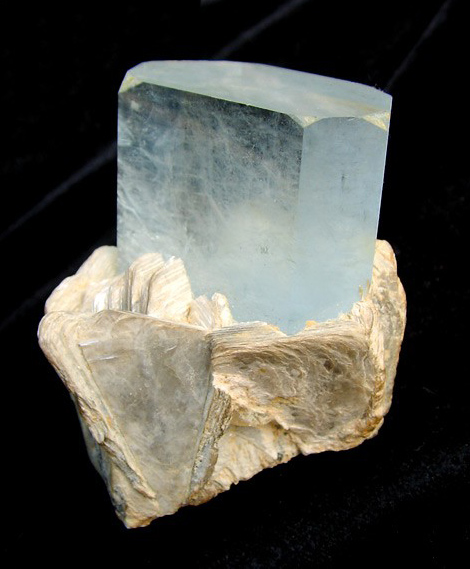The Mineral aquamarine

Aquamarine is the greenish-blue to blue variety of Beryl. It forms in beautiful crystals that can be quite large and totally transparent. Unlike Emerald which usually is flawed or heavily included, Aquamarine can form in stunning flawless crystals, creating some of the most beautiful mineral masterpieces.
Duller or greenish colored stones can be heated to very high temperatures in which they can attain a beautiful sky-blue color. In fact, much of the Aquamarines used as gemstones are actually heat treated.
For additional information, see the gemstone section on Aquamarine.
Chemical Formula
Be3Al2Si6O18
Color
Greenish-blue, light blue, sky blue, deep sky-blue
Properties
Streak
Colorless |
Hardness
7.5 - 8 |
Transparency
Transparent to translucent |
Specific Gravity
2.6 - 2.9 |
Luster
Vitreous |
Cleavage
3,1 - basal |
Fracture
Uneven to conchoidal |
Tenacity
Brittle |
Crystal Habits
Often as perfect, six-sided hexagons, and usually in individual prismatic crystals. Also in short, stubby crystals, and
occasionally in tabular crystals and flattened hexagonal plates.
The
bases of Beryl crystals are usually flat; pyramidal
terminations are less common. Also occurs in columnar aggregates, in distorted etched crystals, and in
massive form. Occasionally in drusy or platy aggregates and as
bundles of thin, long crystals.
Crystals may be striated lengthwise.
Uses
Aquamarine is the most popular light-blue gemstone, and is extensively used in jewelry. Rings, earrings, and bracelets are made from Aquamarine, and it is especially important as a pendant stone, with fairly large pendants being faceted from Aquamarine. Very large display gems, that are too large for standard jewelry use, are occasionally faceted for exclusive collectors. Less transparent stones may be cut into cabochons. Quality Aquamarine crystals are also highly
valued by collectors in their natural form.
Noteworthy Localities
Despite the relatively abundant supply of fine Aquamarine, good crystals still demand a premium. Numerous localities worldwide produce outstanding specimens; this list is by no means complete. Brazil is a major producer of Aquamarine, especially in the Jequitinhonha valley region in Minas Gerais, where it occurs in the areas of Araçuaí, Coronel Murta, Palmital, and Pedra Azul (especially at the Medina pegmatite field.) Other Brazilian occurrences are Guaratinga, in Bahia, where the Aquamarine forms in gemmy tower-shaped crystals; and in Mimoso do Sul, in Espírito Santo.
Pakistan undoubtedly produces the most outstanding crystals of Aquamarine, and some of these crystals can be huge gemmy giants. There are several important deposits in the northern mountains; particular noteworthy are the Shigar Valley, Skardu District, Baltistan; and Nagar, Hunza Valley, Gilgit District.
Beautiful Aquamarine crystals have been coming out of China at Mt. Xuebaoding, Pingwu, in the Sichuan Province; and from Nepal at Taplejung. In Russia, fine specimens have come from Mursinka, Yekaterinburg, in the Ural Mountains; and at Adun-Cholon, in Nerchinsk.
Mogok, Burma (Myanmar) is also an important producer, as are the Jos Plateau, Nigeria; and Marijao and Sahatany, Madagascar. A locality of special note is Erongo, Namibia, where an intensely colored Aquamarine is found that is especially treasured by collectors.
U.S. localities that produce gemmy Aquamarine crystals are Mt. Antero, Chaffee Co., Colorado; the Sawtooth Mts, Boise Co., Idaho; Cahuilla Mountain, Riverside Co., California; and the California Blue Mine, Yucca Valley, San Bernardino Co., California. Aquamarine was also found on the East Coast at Haddam and Portland, Middlesex Co., Connecticut; and at Royalston, Worcester Co., Massachusetts.
Distingushing Similar Minerals
Apatite - Much softer.
Topaz - Forms in different crystals.
Blue Tourmaline - Usually striated lengthwise, different crystal form.
Celestine - Much softer, different crystal habits.